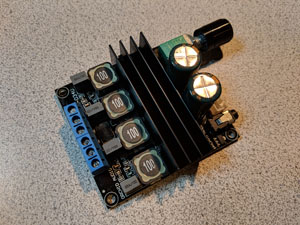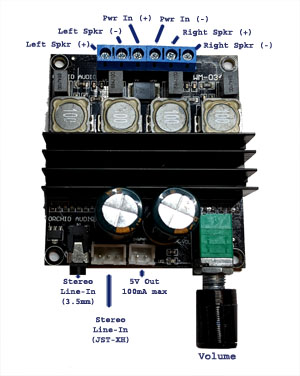 I recently picked up a DROK two channel stereo amplifier board for a little robotics project I’ve been working on. I wasn’t previously familiar with DROK products. And given that the board was relatively cheap at $21, I figured it wasn’t that much of a gamble.
I recently picked up a DROK two channel stereo amplifier board for a little robotics project I’ve been working on. I wasn’t previously familiar with DROK products. And given that the board was relatively cheap at $21, I figured it wasn’t that much of a gamble.
The TPA3116D2 amplifier is pretty basic. It has an adjustable volume and supports stereo audio using two 50W speakers. It can also run on a range of voltages – anywhere from 10-25 volts DC. DROK recommends 4-8 ohm speakers, which I also picked up. The specs for the board claim a frequency response range of 14-100KHz.
The board has two stereo audio inputs – a 3.5mm barrel connector and a 3-pin JST-XH connector. Both of these accept line-level audio. Next to the 3 pin JST-XH connector is another 2-pin JST-XH connector that serves as a 5V output. It can only deliver a max current of 100mA, which isn’t much. But you MIGHT be able to run a fan off that. Next to the 5V connector are power LEDs and next to those is the volume control knob.
On the other end of the board is a terminal strip supporting six connections. The two outer pairs of connectors go to the speakers. The inner pair is for powering the amplifier board.
A wiring diagram for the board is shown below.

The TPA3116D2 arrived sealed in an anti-static bag. There was no packaging beyond that and no documentation, which isn’t uncommon with cheap hardware. I’m sure it keeps prices down, but it always disappoints me a little bit. Interestingly enough, I couldn’t actually find this product on DROK’s website. I’m not sure if it’s discontinued or what. Any questions I had about the product I posted to DROK’s public forum. Fortunately, DROK techs were very responsive and helpful, often responding to my posts in less than 6 hours.
The board is mostly pretty straightforward to wire up. The volume levels are good. The sound quality is so-so. It’s not exactly going to impress audiophiles. But for applications such as mine, it’s fine. I’ve read reviews from other folks claiming that noisy power supplies can distort the audio or produce a hum. But I’ve yet to be affected by this. The board also seems to run a little hot when in heavy use. DROK claims this is normal. Throwing a fan on that 5V 100mA connector might not be such a bad idea.
All in all, I highly recommend this board for applications that don’t require high fidelity audio.
